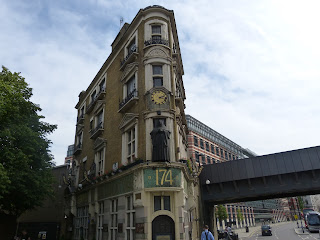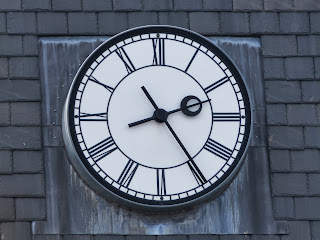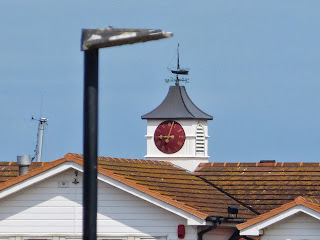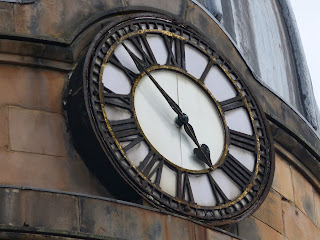The Black Friar pub stands at 174 Queen Victoria Street, opposite Blackfriars station . Although the big debate is whether it is called the Black Friar or the Blackfriar - depends on which source you use.
Anyway, a splendid building on a corner site. The statue of the Black Friar stands like a figurehead on the prow of the building, ready to sail off on the nearby Thames.
The dates also seem to vary as to when this pub was built - it is either 1890 or 1905. The web site British Listed Buildings has it down as c.1875, remodelled in 1905 and 1917. It is Grade II* listed.
The clock itself has a gold mosaic face, but is somewhat past its best. And it is no longer in working order, or at least not showing the right time. Perhaps Nicholson's pubs could be persuaded into a little bit a restoration, especially as it now faces the swish new Blackfriars station
Previous posts in the City of London series are:
1. St Mary Woolnoth - 28 January 2013
2. St Olave Jewry - 20 April 2013
3. The Royal Exchange - 27 April 2013
A random look at public clocks in Britain, covering those on shops, public buildings, railway stations etc.
Sunday, 28 July 2013
Sunday, 21 July 2013
Hartlepool
This is the final stop on my recent clock-spotting tour of north-east England.
Let's start with a bit of shopping at Morrison's.
Followed by this nightclub in The Avenue.
Next up is a turret clock on an NHS premises on Victoria Road.
H Lamb is a family-run jewellers shop on York Road. "Potts of Leeds - Five Generations of Clockmakers" lists a clock of 1939 for H Lamb in their previous premises in Lynn Street. I don't know whether this is the same clock.
A little bit further down the road is Maynews newsagents.
This next grand building is the old Hartlepool Co-operative Society building in Park Road. Completed in 1915, it has now more recently been converted into flats.
Sadly the only remains of the clock are this skeleton dial.
Down the road from the Co-op building, past the brewery, is Stranton Church (All Saints).
Into the hell that is indoor shopping malls. This is the Middleton Grange Shopping Centre, built in 1969 and officially opened by Princess Anne in May 1970. Apparently it was originally an open air shopping centre until converted into an indoor centre in 1992 (which in my view is a bonkers idea). The end result is a ground floor that has oppressively low ceilings, and an upper floor with a glass roof that makes it stifling hot.
Anyway, there are two clocks. The first is a standard small timepiece by the information point.
And the second is this more unusual (but not necessarily attractive) design:
The external design of the shopping centre can be simply described as dreadful. One side of its awfulness has the temerity to face a square with a huge war memorial. having said that, on the opposite side of the road is a brutal brick building that is Hartlepool Civic Centre - a building that does not have a lot of 'civic' about it.
Lets move on, to a time when shops were more civilised. This building now houses Wilkinsons, but was originally Binns department store.
Hopefully the netting around the clock tower is a sign of preservation or restoration. I believe that this is a Potts clock of 1902.
Also a Potts clock is the one on the Hartlepool Art Gallery, originally Christ Church. The timepiece dates form 1919.
Next up is a view of the clock in the Quayside Maritime Experience museum. I didn't have time to go and get a better view of the clock, so we will have to make do with this one.
The modern turret clock seems to be the in thing in the marina area. Here are two more:
This though is a much older clock. I didn't have time to explore further - I think this might be the Customs House of 1911.
We end our tour of Hartlepool with this delightful building, the Dock Office of 1846.
Let's start with a bit of shopping at Morrison's.
Followed by this nightclub in The Avenue.
Next up is a turret clock on an NHS premises on Victoria Road.
H Lamb is a family-run jewellers shop on York Road. "Potts of Leeds - Five Generations of Clockmakers" lists a clock of 1939 for H Lamb in their previous premises in Lynn Street. I don't know whether this is the same clock.
A little bit further down the road is Maynews newsagents.
This next grand building is the old Hartlepool Co-operative Society building in Park Road. Completed in 1915, it has now more recently been converted into flats.
Sadly the only remains of the clock are this skeleton dial.
Down the road from the Co-op building, past the brewery, is Stranton Church (All Saints).
Into the hell that is indoor shopping malls. This is the Middleton Grange Shopping Centre, built in 1969 and officially opened by Princess Anne in May 1970. Apparently it was originally an open air shopping centre until converted into an indoor centre in 1992 (which in my view is a bonkers idea). The end result is a ground floor that has oppressively low ceilings, and an upper floor with a glass roof that makes it stifling hot.
Anyway, there are two clocks. The first is a standard small timepiece by the information point.
And the second is this more unusual (but not necessarily attractive) design:
The external design of the shopping centre can be simply described as dreadful. One side of its awfulness has the temerity to face a square with a huge war memorial. having said that, on the opposite side of the road is a brutal brick building that is Hartlepool Civic Centre - a building that does not have a lot of 'civic' about it.
Lets move on, to a time when shops were more civilised. This building now houses Wilkinsons, but was originally Binns department store.
Hopefully the netting around the clock tower is a sign of preservation or restoration. I believe that this is a Potts clock of 1902.
Also a Potts clock is the one on the Hartlepool Art Gallery, originally Christ Church. The timepiece dates form 1919.
A more modern design can be found on top of MacDonald's near the marina.
Next up is a view of the clock in the Quayside Maritime Experience museum. I didn't have time to go and get a better view of the clock, so we will have to make do with this one.
The modern turret clock seems to be the in thing in the marina area. Here are two more:
This though is a much older clock. I didn't have time to explore further - I think this might be the Customs House of 1911.
We end our tour of Hartlepool with this delightful building, the Dock Office of 1846.
Friday, 19 July 2013
Sunderland
Let's move south of Newcastle to Sunderland, from the River Tyne to the River Wear. Crossing the bridge from the north, the first clock we encounter is on a building on the corner of Bridge Street and High Street West.
The clock tower sits proudly over the closed sweet shop called Sweet Home Alabama (or actually make that sits somewhat embarrassed over).
Joplings is at the corner of John Street and St Thomas Street. The building was purpose built as a department store in 1956 after the original one burnt down two years earlier. Sadly the store (which had the first escalator in Sunderland) ceased trading in June 2010.
I love this clock - it is a very simple design that works well for its size and location.
The next two pictures are of clocks seen from a distance from a footbridge over the A1018 - apologies that I didn't have time to go and explore them close up.
The photo above is of the Church of Holy Trinity in Church Street East, opened in 1719 and closed for worship in 1988. The clock itself was added in 1856.
The photo below is of the Quayside Exchange on Wylam Wharf, a Grade II listed building dating from 1814.
Back to the town centre (or city centre I should say). Another modern design, this time on an empty office building next to the Post Office on Fawcett Street.
The building is up for sale by Sunderland City Council, so I assume that it was originally some form of civic building. Part of the ground floor is occupied by a record shop (Pop Recs Ltd).
We move on to Waterloo place outside of the railway station, and to this example above a betting shop.
The clock is somewhat worse for wear, although the second face around the corner is in much better (no pun intended) condition.
Not much to say about this next one. A small clock mounted above the manager's office in the Park Lane Interchange.
Next door is the West Park United Reform Church on Stockton Road, a Grade II listed building of 1883.
This splendid building in Green Street was once the technical college, but is now sadly a collection of various eateries and clubs. It is named the Galen Building and completed in 1901. It was built under powers granted to local authorities by the Local Taxation (Custom and Excise) Act of 1890 to draw central funds for technical education.
The face is damaged, although is intact on the other side. Unusually for a clock of this type, the numerals used are Arabic rather than Roman.
Next stop is Sunderland Minster, renamed in 1998 after Sunderland was granted city status six years earlier.
Opposite is the marvellous building that is the Dun Cow pub. The whole design is lovely, but the roof line is particularly splendid.
A quick quiz question - what on earth is this archway? I have to assume that this belongs to an earlier building on the site, and was retained in situ when the modern office block was constructed. it is rather incongruous, but somehow seems to work.
Next door is the Magistrates Court.
This is a shot down High Street West, showing the Rotary clock, the M&S timepiece (see below for both of these) and in the distance the Bridge Street clock that we started with.
This cuboid clock marks the golden jubilee of the Sunderland Rotary Club (1922 - 1972)
And finally, good old M&S. Nothing more to say really.
The clock tower sits proudly over the closed sweet shop called Sweet Home Alabama (or actually make that sits somewhat embarrassed over).
Joplings is at the corner of John Street and St Thomas Street. The building was purpose built as a department store in 1956 after the original one burnt down two years earlier. Sadly the store (which had the first escalator in Sunderland) ceased trading in June 2010.
I love this clock - it is a very simple design that works well for its size and location.
The next two pictures are of clocks seen from a distance from a footbridge over the A1018 - apologies that I didn't have time to go and explore them close up.
The photo above is of the Church of Holy Trinity in Church Street East, opened in 1719 and closed for worship in 1988. The clock itself was added in 1856.
The photo below is of the Quayside Exchange on Wylam Wharf, a Grade II listed building dating from 1814.
Back to the town centre (or city centre I should say). Another modern design, this time on an empty office building next to the Post Office on Fawcett Street.
The building is up for sale by Sunderland City Council, so I assume that it was originally some form of civic building. Part of the ground floor is occupied by a record shop (Pop Recs Ltd).
We move on to Waterloo place outside of the railway station, and to this example above a betting shop.
The clock is somewhat worse for wear, although the second face around the corner is in much better (no pun intended) condition.
Not much to say about this next one. A small clock mounted above the manager's office in the Park Lane Interchange.
Next door is the West Park United Reform Church on Stockton Road, a Grade II listed building of 1883.
This splendid building in Green Street was once the technical college, but is now sadly a collection of various eateries and clubs. It is named the Galen Building and completed in 1901. It was built under powers granted to local authorities by the Local Taxation (Custom and Excise) Act of 1890 to draw central funds for technical education.
The face is damaged, although is intact on the other side. Unusually for a clock of this type, the numerals used are Arabic rather than Roman.
Next stop is Sunderland Minster, renamed in 1998 after Sunderland was granted city status six years earlier.
Opposite is the marvellous building that is the Dun Cow pub. The whole design is lovely, but the roof line is particularly splendid.
A quick quiz question - what on earth is this archway? I have to assume that this belongs to an earlier building on the site, and was retained in situ when the modern office block was constructed. it is rather incongruous, but somehow seems to work.
Next door is the Magistrates Court.
This is a shot down High Street West, showing the Rotary clock, the M&S timepiece (see below for both of these) and in the distance the Bridge Street clock that we started with.
This cuboid clock marks the golden jubilee of the Sunderland Rotary Club (1922 - 1972)
And finally, good old M&S. Nothing more to say really.
Subscribe to:
Posts (Atom)











































































